RDF
Identifying the Pathways for Meaning Circulation using Text Network Analysis. By Dmitry Paranyushkin, Nodus Labs.
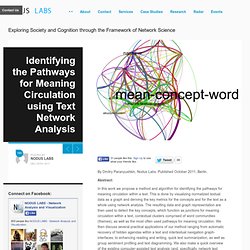
Published October 2011, Berlin. Abstract: In this work we propose a method and algorithm for identifying the pathways for meaning circulation within a text. This is done by visualizing normalized textual data as a graph and deriving the key metrics for the concepts and for the text as a whole using network analysis. The resulting data and graph representation are then used to detect the key concepts, which function as junctions for meaning circulation within a text, contextual clusters comprised of word communities (themes), as well as the most often used pathways for meaning circulation.
Tutorial. What is it and what is it good for?
What is RDF and what is it good for?
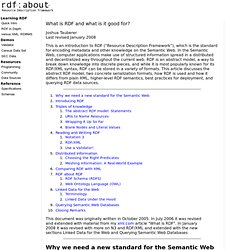
Why we need a new standard for the Semantic Web On the Semantic Web, computers do the browsing for us. The “SemWeb” enables computers to seek out knowledge distributed throughout the Web, mesh it, and then take action based on it. To use an analogy, the current Web is a decentralized platform for distributed presentations while the SemWeb is a decentralized platform for distributed knowledge. RDF is the W3C standard for encoding knowledge. There of course is knowledge on the current Web, but it's off limits to computers.
What is meant by “semantic” in the Semantic Web is not that computers are going to understand the meaning of anything, but that the logical pieces of meaning can be mechanically manipulated by a machine to useful ends. So now imagine a new Web where the real content can be manipulated by computers.
Nested set model. Motivation[edit] Several resolutions exist and are available in some relational database management systems: support for a dedicated hierarchy data type, such as in SQL's hierarchical query facility;extending the relational language with hierarchy manipulations, such as in the nested relational algebra.extending the relational language with transitive closure, such as SQL's CONNECT statement; this allows a parent-child relation to be used, but execution remains expensive;the queries can be expressed in a language that supports iteration and is wrapped around the relational operations, such as PL/SQL, T-SQL or a general-purpose programming language When these solutions are not available or not feasible, another approach must be taken.
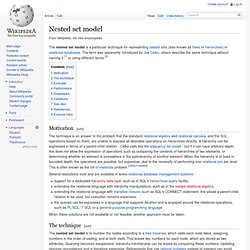
The technique[edit] The nested set model is to number the nodes according to a tree traversal, which visits each node twice, assigning numbers in the order of visiting, and at both visits. Example[edit] A hierarchy: types of clothing. Rdflib 3.2.1 — rdflib 3.2.1 documentation. RDFLib is a pure Python package work working with RDF.
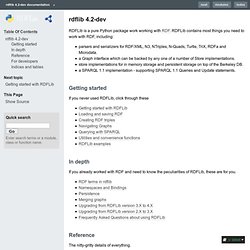
RDFLib contains most things you need to work with RDF, including: parsers and serializers for RDF/XML, N3, NTriples, N-Quads, Turtle, TriX, RDFa and Microdata.a Graph interface which can be backed by any one of a number of Store implementations.store implementations for in memory storage and persistent storage on top of the Berkeley DB.a SPARQL 1.1 implementation - supporting SPARQL 1.1 Queries and Update statements. Getting started If you never used RDFLib, click through these In depth If you already worked with RDF and need to know the peculiarities of RDFLib, these are for you.
Indices and tables functional properties A functional property is a property that can have only one (unique) value y for each instance x, i.e. there cannot be two distinct values y1 and y2 such that the pairs (x,y1) and (x,y2) are both instances of this. RDFLib (RDFLib)
Getting started with rdflib — rdflib v3.0.0 documentation. Create an Rdflib Graph You might parse some files into a new graph (Introduction to parsing RDF into rdflib graphs) or open an on-disk rdflib store. from rdflib.graph import Graphg = Graph()g.parse(" LiveJournal produces FOAF data for their users, but they seem to use foaf:member_name for a person’s full name.
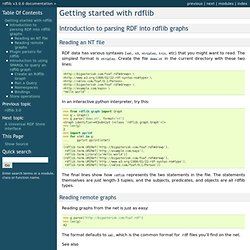
For this demo, I made foaf:name act as a synonym for foaf:member_name (a poor man’s one-way owl:equivalentProperty): from rdflib.namespace import NamespaceFOAF = Namespace(" FOAF['name'], n)) for s,_,n in g.triples((None, FOAF['member_name'], None))] Run a Query The rdflib package concentrates on providing the core RDF types and interfaces for working with RDF. In order to perform SPARQL queries, you need to install the companion rdfextras package which includes a SPARQL plugin implementation: In order to use the SPARQL plugin in your code, the plugin must first be registered.
Continuing the example... The results are tuples of values in the same order as your SELECT arguments. Namespaces.





